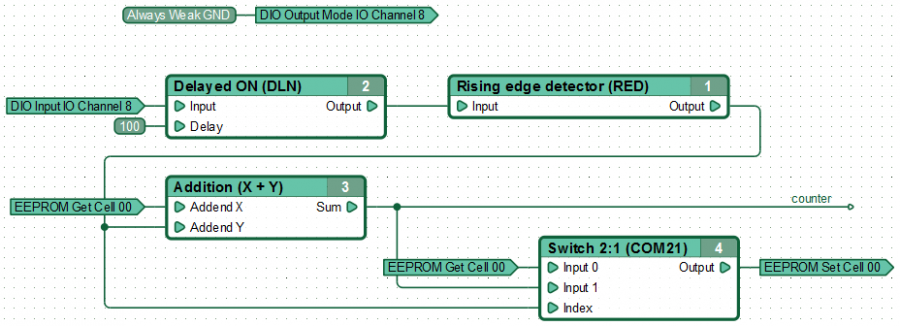| This documentation is out of date.
The new version of the documentation is here: https://cannylogic.com/docs |
Difference between revisions of "CANNY 5.3 pico, EEPROM Driver"
| [checked revision] | [pending revision] |
(Created page with "== General description == To eliminate loss of critical information (state of the controller, external devices status, and so on..) in case of power reset, CANNY 5.3 pico con...") |
(→Nonvolatile memory registers) |
||
| (One intermediate revision by one other user not shown) | |||
| Line 41: | Line 41: | ||
{|border="1" style="border-collapse:collapse;" align="left" width="100%" | {|border="1" style="border-collapse:collapse;" align="left" width="100%" | ||
|- align="center" valign="top" | |- align="center" valign="top" | ||
| − | !width="250px"| | + | !width="250px"|Address |
!Return values | !Return values | ||
|- valign="top" | |- valign="top" | ||
| Line 67: | Line 67: | ||
An example of a functional diagram with non-volatile memory cells. | An example of a functional diagram with non-volatile memory cells. | ||
| − | [[File: | + | [[File:16_15_2_1.PNG|900px]] |
The number of a button clicks that is connected to controller's channel #8, is added to the previously stored in the network named "counter" values. The value of the network «counter» are stored in non-volatile memory when the button is released. After turning off and then restoring controller's power, a value stored in non-volatile memory cell is automatically read and transmitted back to the network named "counter". This avoids loss of information on the number of clicks on this button after controller power loss. | The number of a button clicks that is connected to controller's channel #8, is added to the previously stored in the network named "counter" values. The value of the network «counter» are stored in non-volatile memory when the button is released. After turning off and then restoring controller's power, a value stored in non-volatile memory cell is automatically read and transmitted back to the network named "counter". This avoids loss of information on the number of clicks on this button after controller power loss. | ||
Latest revision as of 01:03, 1 October 2020
General description
To eliminate loss of critical information (state of the controller, external devices status, and so on..) in case of power reset, CANNY 5.3 pico controller equipped with non-volatile memory. The values saved in EEPROM will be available in special registers after the power is restored.
There are 64 16-bit non-volatile memory cells, which are accessed by corresponding read and write registers.
| Note: | Working with non-volatile memory does not require any special pre-configuration. |
Nonvolatile memory registers
Below is a description of permissible values of controller nonvolatile memory setup registers. They are used to store information in the NVRAM cells.
| Address | Expected values | ||||||
|---|---|---|---|---|---|---|---|
|
|
Below is a description of acceptable values controller non-volatile memory read registers. They are used to restore information from the NVRAM cells.
| Address | Return values | ||||||
|---|---|---|---|---|---|---|---|
|
|
Examples
An example of a functional diagram with non-volatile memory cells.
The number of a button clicks that is connected to controller's channel #8, is added to the previously stored in the network named "counter" values. The value of the network «counter» are stored in non-volatile memory when the button is released. After turning off and then restoring controller's power, a value stored in non-volatile memory cell is automatically read and transmitted back to the network named "counter". This avoids loss of information on the number of clicks on this button after controller power loss.
| Note: | The process of storing data in the NVRAM takes time, i.e. not instantaneous. |
| Note: | The number of overwrites information in non-volatile memory is limited. CANNY 5.3 pico memory operation driver is organized in such a way that substantially increased its resource. However, avoid permanent unwanted data saving in to the NVRAM or store data on each execution cycle of the diagram. Perform information preservation upon a certain condition (see example above). |
